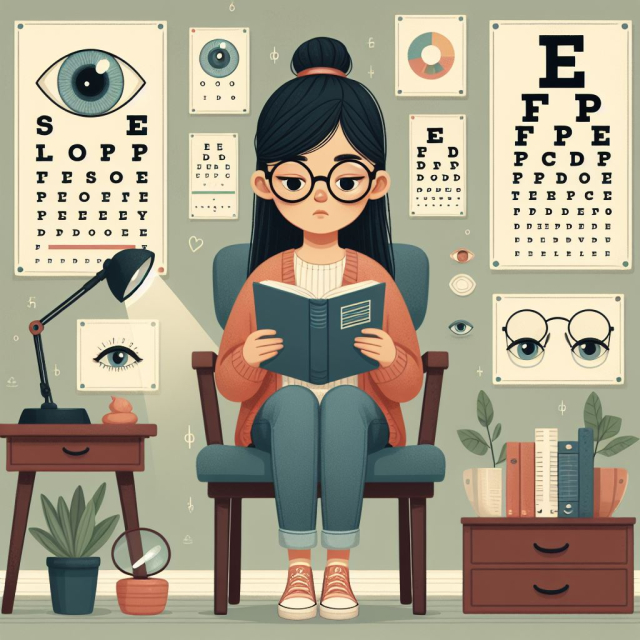Sight is one of the most precious and complex senses of the human being. Vision problems can range from minor inconveniences to serious conditions that threaten the ability to see. These problems affect millions of people around the world, from children to older adults. In this article, we will explore various vision problems, their causes, symptoms and treatments, as well as the importance of prevention and eye care.
Common Types of Vision Problems.
Myopia.
Myopia, or nearsightedness, is a common problem in which people can see close objects clearly, but have difficulty seeing objects in the distance. This occurs when the eyeball is too long or the cornea has too much curvature, causing light to focus in front of the retina instead of directly on it.
Symptoms:
- Difficulty seeing distant objects.
- Headache.
- Eye fatigue.
Treatments:
- Glasses or corrective contact lenses.
- Refractive surgery, such as LASIK.
Farsightedness.
Hyperopia, or long vision, is the opposite of myopia. People with farsightedness can see distant objects clearly, but have difficulty seeing close objects. This is due to a shorter than normal eyeball or a cornea with too little curvature, which causes light to focus behind the retina.
Symptoms:
- Difficulty seeing close objects.
- Tired eyes.
- Blurred vision up close.
Treatments:
- Glasses or corrective contact lenses.
- Refractive surgery.
Astigmatism.
Astigmatism is an imperfection in the curvature of the cornea or lens, causing blurred vision at any distance. This problem may be present from birth or develop over time.
Symptoms:
- Blurred or distorted vision.
- Eye fatigue.
- Difficulty seeing at night.
Treatments:
- Glasses or corrective contact lenses.
- Refractive surgery.
Presbyopia.
Presbyopia is an age-related condition that generally develops after the age of 40. As the eye's lens loses flexibility, it becomes more difficult to focus on close objects.
Symptoms:
- Difficulty reading small print.
- Need to move objects further away to see them clearly.
- Eye fatigue.
Treatments:
- Reading glasses.
- Bifocal or progressive lenses.
- Refractive surgery.
Waterfalls.
Cataracts are a clouding of the lens of the eye that can cause blurred vision and decreased night vision. Cataracts can develop with age or be caused by diseases such as diabetes.
Symptoms:
- Blurry vision.
- Glare and halos around lights.
- Frequent change in glasses prescription.
Treatments:
- Cataract surgery to replace the cloudy lens with an artificial lens.
Glaucoma.
Glaucoma is a disease that damages the optic nerve, often due to increased intraocular pressure. If left untreated, it can lead to loss of peripheral vision and eventually blindness.
Symptoms:
- Loss of peripheral vision.
- Eye pain.
- Blurry vision.
Treatments:
- Medications to reduce eye pressure.
- Laser surgery.
- Filtration surgery.
Age-Related Macular Degeneration (AMD).
AMD affects the macula, the central part of the retina responsible for central, detailed vision. It is one of the main causes of vision loss in older people.
Symptoms:
- Blurred or distorted central vision.
- Difficulty reading and recognizing faces.
- Appearance of dark areas in central vision.
Treatments:
- Injectable therapies.
- Specific vitamin supplements.
- Photodynamic therapy.
Diabetic retinopathy.
Diabetic retinopathy is a complication of diabetes that affects the blood vessels of the retina. It can cause vision loss and, in severe cases, blindness.
Symptoms:
- Blurry vision.
- Loss of vision.
- Spots or floating points in vision.
Treatments:
- Strict blood sugar control.
- Laser therapy.
- Intravitreal injections.
Prevention and Vision Care.
Regular Vision Exams.
Regular eye exams are essential to detect vision problems in their early stages. It is recommended that adults have an eye exam every two years, or more frequently if they have risk factors such as diabetes or a family history of eye diseases.
Eye Protection.
Wearing UV-blocking sunglasses can protect your eyes from sun damage. Additionally, wearing safety glasses is crucial in hazardous work environments or when playing sports.
Healthy life style.
Eating a diet rich in vitamins and antioxidants, such as those found in fruits and vegetables, can contribute to eye health. Regular exercise also improves blood circulation, which is beneficial for eye health.
Management of Chronic Diseases.
Controlling chronic diseases such as diabetes and hypertension is crucial to preventing eye complications such as diabetic retinopathy and glaucoma.
Hygiene and Care of Contact Lenses.
For those who wear contact lenses, it is vital to follow good hygiene and the optometrist's instructions to avoid eye infections.
Responsible Use of Electronic Devices.
Prolonged exposure to screens can cause eye fatigue. It's a good idea to follow the 20-20-20 rule: every 20 minutes, look at something 20 feet away for at least 20 seconds.
Vision problems are diverse and can have a significant impact on quality of life. Early detection, proper treatment, and prevention practices can help maintain good eye health and prevent vision loss. It is essential to be informed and take proactive measures to protect one of our most valuable senses. Taking care of your eyesight not only improves the quality of life, but also allows you to fully enjoy the wonders of the visual world.






